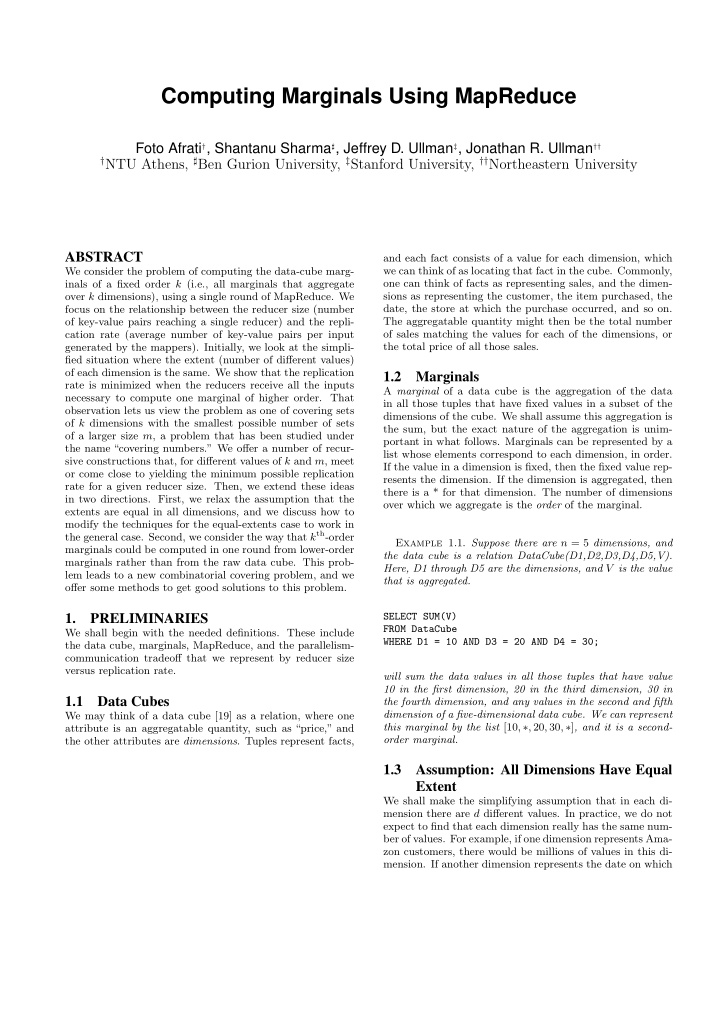



Computing Marginals Using MapReduce Foto Afrati † , Shantanu Sharma ♯ , Jeffrey D. Ullman ‡ , Jonathan R. Ullman †† † NTU Athens, ♯ Ben Gurion University, ‡ Stanford University, †† Northeastern University ABSTRACT and each fact consists of a value for each dimension, which we can think of as locating that fact in the cube. Commonly, We consider the problem of computing the data-cube marg- inals of a fixed order k (i.e., all marginals that aggregate one can think of facts as representing sales, and the dimen- sions as representing the customer, the item purchased, the over k dimensions), using a single round of MapReduce. We focus on the relationship between the reducer size (number date, the store at which the purchase occurred, and so on. The aggregatable quantity might then be the total number of key-value pairs reaching a single reducer) and the repli- cation rate (average number of key-value pairs per input of sales matching the values for each of the dimensions, or the total price of all those sales. generated by the mappers). Initially, we look at the simpli- fied situation where the extent (number of different values) of each dimension is the same. We show that the replication 1.2 Marginals rate is minimized when the reducers receive all the inputs A marginal of a data cube is the aggregation of the data necessary to compute one marginal of higher order. That in all those tuples that have fixed values in a subset of the observation lets us view the problem as one of covering sets dimensions of the cube. We shall assume this aggregation is of k dimensions with the smallest possible number of sets the sum, but the exact nature of the aggregation is unim- of a larger size m , a problem that has been studied under portant in what follows. Marginals can be represented by a the name “covering numbers.” We offer a number of recur- list whose elements correspond to each dimension, in order. sive constructions that, for different values of k and m , meet If the value in a dimension is fixed, then the fixed value rep- or come close to yielding the minimum possible replication resents the dimension. If the dimension is aggregated, then rate for a given reducer size. Then, we extend these ideas there is a * for that dimension. The number of dimensions in two directions. First, we relax the assumption that the over which we aggregate is the order of the marginal. extents are equal in all dimensions, and we discuss how to modify the techniques for the equal-extents case to work in the general case. Second, we consider the way that k th -order Example 1.1. Suppose there are n = 5 dimensions, and marginals could be computed in one round from lower-order the data cube is a relation DataCube(D1,D2,D3,D4,D5,V). marginals rather than from the raw data cube. This prob- Here, D1 through D5 are the dimensions, and V is the value lem leads to a new combinatorial covering problem, and we that is aggregated. offer some methods to get good solutions to this problem. SELECT SUM(V) 1. PRELIMINARIES FROM DataCube We shall begin with the needed definitions. These include WHERE D1 = 10 AND D3 = 20 AND D4 = 30; the data cube, marginals, MapReduce, and the parallelism- communication tradeoff that we represent by reducer size versus replication rate. will sum the data values in all those tuples that have value 10 in the first dimension, 20 in the third dimension, 30 in 1.1 Data Cubes the fourth dimension, and any values in the second and fifth dimension of a five-dimensional data cube. We can represent We may think of a data cube [19] as a relation, where one this marginal by the list [10 , ∗ , 20 , 30 , ∗ ] , and it is a second- attribute is an aggregatable quantity, such as “price,” and order marginal. the other attributes are dimensions . Tuples represent facts, 1.3 Assumption: All Dimensions Have Equal Extent We shall make the simplifying assumption that in each di- mension there are d different values. In practice, we do not expect to find that each dimension really has the same num- ber of values. For example, if one dimension represents Ama- zon customers, there would be millions of values in this di- mension. If another dimension represents the date on which
Recommend
More recommend